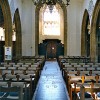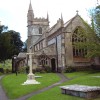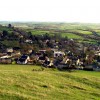Swyre has been the home and the last resting place for members of two of Dorset’s best known families, the Russell’s and the Napier’s, and the Rector here from 1729 until his death in 1778 was John Hutchins whose work The History and Antiquities of the County of Dorset is a main source material for anyone studying the County.
Swyre is a coastal parish about 5 miles east of Bridport that comprises nearly eleven hundred acres of farmland. The church in the Early English style was dedicated to The Holy Trinity in 1503 and stands on the eastern edge of the parish. Its walls are built of local rubble and the roofs are covered with slates. The chancel arch and the west tower survive from c.1400; the nave and chancel were rebuilt in 1843 and in 1885 the vestry and organ-chamber were added. The tower houses two bells both thought to be from the 15th century.
There are brasses in the church and memorials in the churchyard to members of the Gallop and Squibb families and others commemorating the lives of prominent members of the Russell and the Napier families.
About a mile from the church is Berwick House. Built in the 16th century it is the birthplace of John Russell, the first Duke of Bedford. In 1506 a vessel with the Archduke Phillip of Austria and his Spanish wife on board sought shelter in Weymouth harbour. The couple were taken to Wolfeton House, the home of Sir Thomas Trenchard, on the outskirts of Dorchester, and word was sent to Berwick House for his nephew, John Russell, who was a Spanish speaker, to come and interpret. On a later occasion when the Archduke was visiting King Henry VIII, he mentioned to the king the service provided by John Russell and in recognition of his service he was appointed to the King’s Privy chamber.
John Russell had a distinguished career and managed to keep his head, in itself no mean feat for an advisor to the King. He held many posts including that of Ambassador to the Pope. In 1547 he was granted the monastery of Woburn Abbey and in that same year he attended the coronation of King Edward Vl in his position of Lord High Steward of England. He was created Earl of Bedford around 1549 and died in Buckinghamshire on the 14th of March 1554.
In 1851 a school was provided to teach 40 children, by 1895 the Duke of Bedford owned all the land in the parish, although none of the later Dukes resided in Dorset.
From the beginning of the 17th century Berwick House and farm have been leased to tenant farmers. The Napier family, who held land in Swyre, Bexington and Puncknowle appear to have had an interest in Berwick between 1602 and 1641, while Mary, the daughter of Julius Squibb and wife of George Gallop inherited Berwick in 1687. George and Mary Gallop’s son George was the Sheriff of Dorset in 1745, Thomas was Captain of Portland Castle and James was Sheriff of Dorset in 1768.
Arthur Mee, the editor of the 1939 edition of The King’s England, dismisses Swyre in one sentence as “a small, humble and uninteresting settlement.” We beg to differ.



